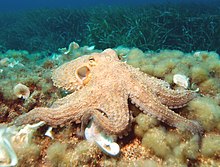Teuthology




Teuthology (from Greek τεῦθος, "cuttlefish, squid", and -λογία, -logia)[1] is the study of cephalopods, which are members of the class Cephalopoda in the phylum Mollusca. Some common examples of cephalopods are octopus, squid, and cuttlefish. Teuthology is a large area of study that covers cephalopod life cycles, reproduction, evolution, anatomy, and taxonomy.
Teuthology is a specific branch of malacology, the study of molluscs. A teuthologist is a scientist who studies teuthology.
Research Highlights
[edit]2023
[edit]The publication of the English translation of Albin O Ebersbach's thesis on the detailed descriptions of cirrate octopods marks an expansion of access to important taxonomical identifying information in teuthology.[2]
The third paper in the series led by Tristian Joseph Verhoeff revisiting cirrate octopods is published.[3]
2022
[edit]Several papers describing new species of cephalopods were published this year. Two of the papers were the beginning of the series led by Tristian Joseph Verhoeff describing new cirrate octopods discovered around Australia and New Zealand.[4][5] The third paper describes two new Sepiolina species also discovered in Australian waters.[6]
Organizations
[edit]The Cephalopod International Advisory Council (CIAC) is a group founded by teuthologists to discuss advancements and growth of cephalopod research.[7][more detail needed]
See also
[edit]References
[edit]- ^ Arnold, John M.; Summers, William C.; Gilbert, Daniel L.; Manalis, Richard S.; Daw, Nigel W.; Lasek, Raymond J. (1974). A Guide to laboratory use of the squid Loligo pealei. Woods Hole, MA: Marine Biological Laboratory. doi:10.1575/1912/224.
- ^ Verhoeff, Tristan Joseph (2023-07-01). "A Translation into English of Ebersbach's "On the Anatomy of Cirroteuthis Umbellata Fischer and Stauroteuthis Sp."—with Comments on Grimpoteuthis". Bulletin of Marine Science. 99 (3): 213–311. doi:10.5343/bms.2022.0052. ISSN 0007-4977.
- ^ Verhoeff, Tristan Joseph (2023-07-01). "A Translation into English of Ebersbach's "On the Anatomy of Cirroteuthis Umbellata Fischer and Stauroteuthis Sp."—with Comments on Grimpoteuthis". Bulletin of Marine Science. 99 (3): 213–311. doi:10.5343/bms.2022.0052. ISSN 0007-4977.
- ^ Verhoeff, Tristan Joseph; O’Shea, Steve (2022-01-02). "New records and two new species of Grimpoteuthis (Octopoda: Cirrata: Grimpoteuthididae) from southern Australia and New Zealand". Molluscan Research. 42 (1): 4–30. Bibcode:2022MollR..42....4V. doi:10.1080/13235818.2022.2035889. ISSN 1323-5818.
- ^ Verhoeff, Tristan Joseph (2022-07-03). "Finned octopus Cirroteuthis Eschricht, 1836 (Cephalopoda: Cirrata: Cirroteuthidae) confirmed from Australian waters". Molluscan Research. 42 (3): 205–211. Bibcode:2022MollR..42..205V. doi:10.1080/13235818.2022.2087143. ISSN 1323-5818.
- ^ Lu, Chung Cheng; Okutani, Takashi (2022-01-04). "Two new genera and species of sepioline squids (Cephalopoda: Sepiolidae) from Australia". Memoirs of Museum Victoria. 81: 1–23. doi:10.24199/j.mmv.2022.81.01.
- ^ "About". Cephalopod International Advisory Council. 2015-11-04. Retrieved 2023-11-17.
